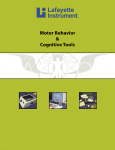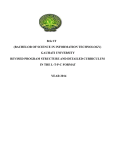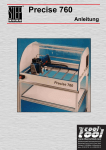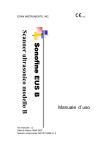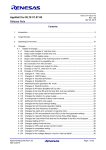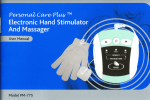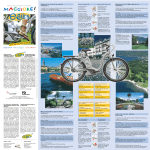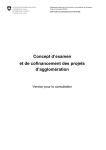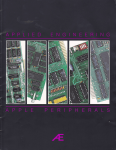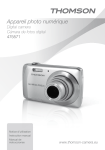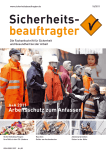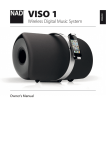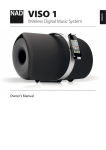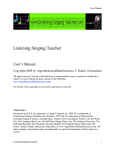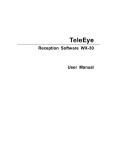Download CogniPlus: Training cognitive functions
Transcript
COGNIPLUS www.schuhfried.com Training cognitive functions For attention, memory, executive functions, spatial processing, visuomotor skills and neglect #03.2 Contents Get in touch! For queries and catalog orders Mon. – Thurs.: 8 a.m. – 5 p.m. Fri.: 8 a.m. – 2 p.m. E-mail [email protected] Telephone +43 2236 42315 Fax Your own personal online demonstration Fast, efficient, personal. Upon request a member of the SCHUHFRIED team will – in the same way as in a webinar – take you through CogniPlus online and answer your questions. You don’t need anything for this personal online tour except a telephone, a computer with internet access and a little time. E-mail +43 2236 46597 [email protected] Website Telephone schuhfried.com 4 YOU GET MORE 4 CogniPlus? CogniPlus! 5 7 reasons to choose CogniPlus +43 2236 42315 Address Find it fast: CogniPlus From A-Z 7 ALERT Attention: Alertness 14 CODING Working memory: Spatial coding 16 Dateup Working memory: Updating – spatial 11 DIVID SCHUHFRIED GmbH Hyrtlstrasse 45 2340 Moedling Austria Attention: Divided 10 FOCUS Attention: Focused 18 HIBIT-R Executive functions: Response inhibition - revised version 17 NAMES Long-term memory: Learning of face-name associations 15 NBACK Working memory: Updating – visual 19 PLAND Executive functions: Help Desk Planning and action skills 20 ROTATE Spatial processing: Mental rotation 9 SELECT Attention: Selective Queries on installation and operation for our customers 12 SPACE Neglect/visual field training: Mon. – Thurs.: 8 .30 a.m. – 4.30 p.m. Fri.: 8 .30 a.m. – 1.30 p.m. Visuospatial attention 8 VIG Attention: Vigilance 21 VISMO Visuomotor coordination E-mail [email protected] Telephone + 43 2236 42315-60 13 VISP Working memory: Rehearsal – visuospatial 6 THE COGNIPLUS TRAINING PROGRAMS 7 Attention 7ALERT – Attention: Alertness 8VIG – Attention: Vigilance 9SELECT – Attention: Selective 10FOCUS – Attention: Focused 11DIVID – Attention: Divided 12 Neglect/field of view training 12 SPACE – Neglect/visual field training: Visuospatial attention 13 Working memory 13VISP – Working memory: Rehearsal – visuospatial 14CODING – Working memory: Spatial coding 15NBACK – Working memory: Updating – visual 16DATEUP – Working memory: Updating – spatial 17 Long-term memory 17NAMES – Long-term memory: Learning of face-name associations 18 Executive functions 18HIBIT-R – Executive functions: Response inhibition - revised version 19PLAND – Executive functions: Planning and action skills 20 Spatial processing 20ROTATE – Spatial processing: Mental rotation 21 Visuomotor skills 21 VISMO – Visuomotor coordination 22 Languages 23 THE VIENNA TEST SYSTEM Neuro 25 THE VIENNA TEST SYSTEM aND COGNIPLUS: A great team! 26 26 26 27 29 TRAINING AT THE COMPUTER User-friendly software Input devices A typical training session Direct training 30 SERVICE About this document: SCHUHFRIED GmbH Hyrtlstrasse 45 2340 Moedling Austria E-mail: [email protected] Internet: www.schuhfried.com Tel.: +43 2236 42315 Fax: +43 2236 46597 Media owner and editor: SCHUHFRIED GmbH Place of publication: Moedling, Austria Release date: 09/2014 Publisher: druck.at, Leobersdorf Editors-in-chief: Doreen Kallweit, Johanna Egle Graphics: Johanna Kurz, www.kurzundkallweit.at Photos: SCHUHFRIED GmbH; fotolia (Cover: Robert Kneschke); shutterstock (Cover: Denis Babenko; p.24 Yuri Arcurs, Konstantin Sutyagin, Alexander Raths, Lisa F. Young, Polina Nefidova; p.23 Yuri Arcurs, rangizzz; p.29 Ilike; p.30 Yuri Arcurs; p.31 Yuri Arcurs; p.34 Daboost ); istock (p.4 LdF; p.33 avdeev007) Copyright © SCHUHFRIED GmbH, Moedling. All rights reserved For the sake of readability the masculine form has been used throughout to designate both genders. 30 Best Practice: CogniPlus in use 34 System requirements 35 Also from SCHUHFRIED: the Vienna Test System & Biofeedback 2000 x-pert Die CogniPlus-Trainingsverfahren You get more You get more 7 reasons to choose CogniPlus 1| Developed by prominent scientists Many prominent scientists, including Prof. Walter Sturm, Prof. Joachim Funke and Prof. Matthias Weisbrod, have worked with experts at SCHUHFRIED to develop CogniPlus. Extensive experience combined with the know-how of the best of the best makes CogniPlus Worth knowing one of the most advanced Prof. Dr. Walter Sturm has been head cognitive training programs on of the clinical neuropsychology dethe market today. partment at the neurological clinic of the medical faculty of RWTH Aachen University since 1995. His main areas of research are neuropsychological assessment, treatment of attention disorders, functional reorganisation after attention therapy and functional imaging of attention functions. Firm foundations: In 1993 Prof. Sturm and his colleagues developed the AIXTENT training program for the treatment of attention disorders. Efficiency studies showed that training must be deficit-specific if it is to be effective. Building on this insight, SCHUHFRIED worked with Prof. Sturm to produce a second-generation version of AIXTENT (AIXTENT II), which later became known as CogniPlus. CogniPlus? CogniPlus! is a product of the SCHUHFRIED company – your specialist in computer-based psychology. 2| is a training system for training cognitive functions. Efficient. Multi-media. Motivating. is scientifically based and incorporates up-to-date psychological findings. The content of CogniPlus is closely linked to the Vienna Test System – internationally the most widely used test system for professional psychological assessment. This means that diagnosis, treatment and evaluation can be efficiently linked. is available in a wide range of languages – at no extra cost. So that each client can train in his own language. Read more … about the interlinking of CogniPlus and the Vienna Test System. ii page 23 Read more … about the language versions. You too can profit from a state-of-the-art program that covers all areas of cognitive training! ii page 22 Based on a function-oriented intervention approach Each CogniPlus training program is tailored to a specific deficit, because studies have shown that use of over-complex training programs may actually cause performance to deteriorate. Training programs are only offered for cognitive functions that are scientifically proven to be trainable. 3| Embedded in a context of scientific theory CogniPlus training programs are always developed in the light of the relevant up-to-date scientific literature. Theory-led design is a top priority. All our partners are noted for their theoretical expertise as well as their practical clinical experience. 4| Realistic and motivating design 5| Adapts automatically to the client's ability Clients want to apply their improved skills as quickly as possible in everyday life. In CogniPlus the ability dimensions being trained are almost always embedded in lifelike scenarios. This has been achieved through collaboration with computer game programmers, who have produced impressive three-dimensional scenes. It is this appealing, modern and motivating appearance that makes CogniPlus popular with clients. CogniPlus is an intelligent interactive system which is neither too easy nor too difficult for the client. It reliably identifies the client's ability level and adapts automatically to it. One of the conditions for successful training is thus met: the users of the program are motivated. 6| Training at all ability levels The CogniPlus training programs can be used across the entire ability range. This opens up completely new opportunities for use alongside the traditional areas of application such as the rehabilitation of patients with brain damage. For example, CogniPlus can be used to improve the driving-related skills of people convicted of traffic offences, to improve the attention of children with ADHD, or to improve the mental activation of patients with MCI. 7| Recommended by respected institutions The Aixtent training programs, which led to the development of the CogniPlus attention training modules, are listed with recommendation strength A in the guidelines of the Society for Neuropsychology (Gesellschaft für Neuropsychologie - GNP, 2009) and the German Society for Neurology (Deutsche Gesellschaft für Neurologie – DGN, 2008). A Recommendation strength Request the demo version now without obligation! 4 . COGNIPLUS COGNIPLUS .5 The CogniPlus training programs The CogniPlus training programs Attention: Alertness ALERT Walter Sturm © SCHUHFRIED GmbH Dimension SubDimension specific function Alertness Intensity Vigilance Attention Selective attention Selectivity Focused attention Divided attention Neglect/visual field training Visuospatial attention Rehearsal – visuospatial Spatial coding Working memory Memory Updating – visual Updating – spatial Long-term memory Executive functions Spatial processing Visuomotor skills Worth knowing When you buy the CogniPlus administration software (or an update) you will receive 20 hours of free training to use with any of the CogniPlus programs. Learning of face-name associations Response inhibition CogniPlusTraining ALERT read more on page 7 VIG read more on page 8 Select read more on page 9 FOCUS read more on page 10 Divid read more on page 11 Space read more on page 12 Visp read more on page 13 Coding read more on page 14 Nback read more on page 15 DATEUP read more on page 16 Names read more on page 17 HIBIT-R read more on page 18 Pland Planning and action skills read more on page 19 Mental rotation Rotate Visuomotor coordination The ALERT training program trains the alertness dimension of attention – the ability to temporarily increase and sustain the intensity of attention. read more on page 20 VISMO Theory When the intensity of attention is temporarily aroused exogenously by a warning signal, phasic alertness is involved. If the arousal occurs without a cue, the situation involves intrinsic alertness. The aim of alertness training must be to increase intrinsic alertness, since only in this case is arousal entirely cognitively controlled. However, where there are deficits related to alertness it is necessary to first improve phasic alertness and only then to proceed to working on intrinsic alertness. Setting and task A motorcycle is driven along a winding road. The client’s task is to carefully observe the stretch of road in front of him and to press the reaction key as quickly as possible when obstacles appear. If the client reacts in time the motorcycle slows down and the obstacle disappears so that the rider can continue on his way. If the reaction is delayed there is an “emergency stop”; there is a loud braking noise, the motorcycle comes to a halt and a yellow exclamation mark appears on the screen. the acoustic and visual warning signals are omitted. The motorcycle then travels through a foggy night-time landscape, in which the obstacles suddenly appear out of the mist. Difficulty structure Each of the two training forms contains 18 difficulty levels. The degree of challenge is increased by shortening the maximum permitted reaction time. At the first level the client has 1.8 seconds in which to react to an obstacle, but at the highest level only 0.3 seconds elapse between the sudden appearance of an obstacle and the emergency braking. At the first session the speed of the client’s initial reactions is assessed and he is assigned to a difficulty level appropriate to his ability. This ensures that from the outset the training program is optimally adapted to the client’s skill and is never either too easy or too difficult for him. Worth knowing Training forms ALERT can also be used with patients The ALERT training program consists of two training forms. The S1 training form trains phasic alertness, while the S2 training form trains intrinsic alertness. In the S1 training form the obstacles designed to externally arouse the client’s attention are preceded by acoustic and visual warning signals. In the S2 training form with disorders of the field of vision. The instruction pages are then displayed on one side of the screen and the obstacles only appear on one side (e.g. trees only fall onto the carriageway from the right). read more on page 21 The range of CogniPlus training programs keeps growing! Visit www.schuhfried.com for the latest information. Corresponding test in the Vienna Test system WAFA 6 . COGNIPLUS COGNIPLUS .7 The CogniPlus training programs VIG The CogniPlus training programs Attention: Vigilance Attention: Selective Walter Sturm © SCHUHFRIED GmbH The VIG training program trains the attention dimension of vigilance – the ability to sustain attention over a lengthy period of time under monotonous stimulus conditions. Theory Long-term alertness tasks require the client’s attention “to be focused continuously for long periods of time on one or more sources of information, in order to detect and respond to small changes in the information presented” (Davies et al. 1984). Vigilance represents a special variant of long-term attention. Vigilance tasks make demands on attention over a long period of time – often a number of hours – and the relevant stimuli typically occur Worth knowing VIG can also be used with patients with at very irregular intervals and at a very low frequency among impaired field of vision. a large number of irrelevant stimuli. Vigilance training cannot be effective unless a training session lasts for more than 30 minutes at the minimum. Setting and task The client is driving along a straight highway. At irregular intervals other vehicles come towards him on the opposite carriageway or overtake him. The client’s task is to react by pressing a button when an overtaking vehicle suddenly brakes in front of him. Once he has reacted the vehicle’s brake lights go out and it accelerates away from him. If the client fails to react within the permitted time, the brake lights start to flash. Eventually there is a loud squealing noise, which is designed to draw the client’s attention to what is happening. Corresponding test in the SELECT Walter Sturm © SCHUHFRIED GmbH The SELECT training program trains selective attention – the ability to respond quickly to relevant stimuli and to suppress inappropriate responses. Difficulty structure Theory Difficulty structure The VIG training program has 30 difficulty levels. A decreasing stimulus frequency makes it more and more difficult for the client to sustain his attention: he is overtaken by other cars increasingly rarely, the surroundings become more monotonous as darkness falls and the number of sudden braking manoeuvres from overtaking vehicles decreases. In addition, the intensity of the feedback on delayed and omitted reactions becomes weaker as the difficulty level increases. The challenge therefore changes gradually from a sustained attention task to one requiring real vigilance. An attention selectivity training program should help the client to distinguish rapidly between relevant and irrelevant aspects of a task. Most selective attention tasks require a quick decision within a set of stimuli in which the relevant and irrelevant items are clearly defined. There are 15 difficulty levels for each training form. SELECT adapts to the client’s ability level in two ways. Firstly, the number of relevant or irrelevant stimuli increases or decreases. Secondly, at each difficulty level the maximum permitted reaction time adapts to the speed Worth knowing of the client’s reactions. Thus SELECT can also be used with patients for a skilled client the wagon with impaired field of vision. gets faster after the first few responses. This ensures that from the outset the training program is optimally adapted to the client’s skill and is never either too easy or too difficult for him. At each difficulty level the maximum permitted reaction time adapts to the speed of the client’s reactions. Taking the client’s first valid reactions as a starting point, an individual reaction time limit is determined and used as a basis for measuring all further reactions made in the course of the training program. This ensures that from the outset the training program is optimally adapted to the client’s skill and is never either too easy or too difficult for him. Setting and task The client travels through a tunnel in a mine car. Relevant and irrelevant stimuli (optical, acoustic or crossmodal) suddenly emerge from the darkness. The client’s task is to respond only to relevant stimuli. If he responds late to a relevant stimulus or fails to respond at all, negative feedback is given in the form of a crash of thunder and a flash of lightning. If the client responds in error to an irrelevant stimulus, the figure or the sound source is illuminated in red. Training forms The SELECT training program consists of three training forms. The S1 training form trains selective attention in the visual modality (figures appear in the tunnel). S2 is the acoustic training form, in which the client’s task is to respond to relevant sounds. In the S3 training form the client is instructed to respond to specific stimulus combinations (figures that make particular noises). Corresponding test in the Vienna Test system Vienna Test system WAFV WAFS 8 . COGNIPLUS COGNIPLUS .9 The CogniPlus training programs FOCUS The CogniPlus training programs Attention: Focused Attention: Divided Walter Sturm © SCHUHFRIED GmbH The FOCUS training program trains focused attention – the ability to respond only to relevant stimuli among a high density of distracting stimuli. Theory Focused attention describes the ability to isolate a segment of reality in order to be able to analyse it more closely. It is particularly important to be able to maintain this focus in the face of distractions and to suppress the interference caused by the simultaneous and automatic processing of information. Setting and task A boat travels through a lush African landscape. The client is confronted with a wide range of different stimuli: screeching birds, flying dragonflies, a ruin on the banks of a river, a waterfall etc. His task is to respond to pre-defined relevant stimuli without letting himself be distracted by the large number of other stimuli. Corresponding test in the DIVID Walter Sturm © SCHUHFRIED GmbH The DIVID training program trains divided attention – the ability to perform different tasks simultaneously. Training forms Theory The FOCUS training program consists of two training forms, each of which has ten difficulty levels: T he S1 training form requires the client to recognise visual stimuli against a background of distracting stimuli which may be acoustic, visual, or a combination of the two. I n the S2 training form the task is to detect acoustic stimuli in the face of other stimuli which may likewise be acoustic, visual, or a combination of both. The ability to divide one’s attention depends on the processing resources available and on the nature of the combined tasks. The more similar the tasks, the greater the interference that arises between them (Wickens, 1984). In everyday life the ability to split one’s attention is relevant to many skills – for example, driving a car, which normally requires the simultaneous monitoring of a number of different information streams. Difficulty structure In this training program the client takes on the role of a security official at an airport. He has to simultaneously observe both a range of scenes on several control monitors (sliding doors at the entrance, ticket counter, luggage conveyor) and announcements made over the loudspeaker system. His task is to deal with problems that occur by pressing the response key. If the client fails to react promptly to a problem or a relevant announcement, the picture is frozen on all channels and the channel on which the problem occurred is highlighted. The events displayed do not continue until the reaction button is pressed. The difficulty structure of the FOCUS training program is designed to adapt as far as possible to the amount that the client can take in. Thus a client of weak ability will be presented with a low-stimulus environment, while a client of strong ability will be confronted with a large number of distractor stimuli. The number of distractor stimuli presented is carefully graded and the time allowed for identification of a stimulus is adapted to the client’s skill. Setting and task Difficulty structure DIVID has 15 difficulty levels. The difficulty levels vary in terms of the number of channels that the client has to monitor, the frequency of breakdowns, the minimum interval between two breakdowns and the maximum time allowed for noticing a breakdown. Corresponding test in the Vienna Test system Vienna Test system WAFF WAFG 10 . COGNIPLUS COGNIPLUS . 11 The CogniPlus training programs SPACE The CogniPlus training programs Neglect/visual field training: Visuospatial attention Working memory: Rehearsal – visuospatial Walter Sturm © SCHUHFRIED GmbH The SPACE training program was created for patients with hemineglect but it can also be used successfully with patients who have an impairment of the visual field. It improves the visuospatial directing of attention and is intended to train the specific ability to direct attention to stimuli on the contralesional side of the field of vision. Theory observation. The task is to take a “photo” by pressing the reaction key as soon the viewfinder stops and has “captured” an object. In each scene there is a fixation point in the center towards which the client should direct the position of his head and the direction of his gaze and where he can find the viewfinder if he has lost sight of it. In everyday life our attention may be focused on a different source from our perceptive organs. Peripheral stimuli lying outside our central field of vision can attract the focus of attention to themselves. They then bring about a change in the direction of gaze or a turning of the head towards an object or event (visuospatial attention). Peripheral cues tend to bring about an automatic (exogenous) spatial shift of attention, while central cues (e.g. an arrow in the fixation point pointing to the left or right) are more likely to produce a cognitively controlled (endogenous) shift of attention, since a particular expectation is generated. Both peripheral and central cues cause a covert shift of attention to the right or left and thus make it easier to detect stimuli in the half of the visual field in which the cues occur or to which they point (valid condition). However, if the cue is in the wrong half or points in the wrong direction (invalid condition), the speed of reaction to the target stimulus is slowed, since attention must first be shifted from the “wrong” focus to the correct spatial position. Difficulty structure Setting and task The instructions for the SPACE training program are displayed on only one side of the screen and are therefore easily read by patients with neglect or visual field impairment. The client assumes the role of a photographer. His task is to observe various scenes such as a market place, airport, office, children’s playground etc. The camera viewfinder moves towards a particular point in the area under Corresponding test in the VISP Dieter Schellig, Uwe Schuri, Walter Sturm © SCHUHFRIED GmbH There are ten different difficulty levels, each of which displays a different scene of interest on the screen. The level of difficulty is increased by varying the way in which the viewfinder moves (continuous movement, jumping Worth knowing movement, with and without We recommend the use of monitors a return to the center) and with a screen diagonal of at least 19" the complexity of the scene. so that the area of the visual field In addition, at the lower lev- being trained is as large as possible. els of difficulty the task is made easier by an acoustic and visual cue (sound and arrow in the middle of the viewfinder) which indicates the direction of the next movement. At the higher levels of difficulty only irregular cues are given, and the cues may give no indication of direction or even be completely wrong – for example, the arrow in the viewfinder may point to the upper right while the viewfinder jumps to the lower left. VISP is a training program for improving active rehearsal in spatial working memory. Theory Difficulty structure Rehearsal processes can improve short-term and longterm memory. However, rehearsal is not a form of simple storage but a controlled and attention-based series of retrievals and re-encodings of material, the aim being to maintain this material from perceptual processing or long-term memory in the focus of attention. Spatial attention is the central process in spatial rehearsal – just as subvocal articulation is the key function for verbal rehearsal. For example, we let our gaze travel repeatedly from one location to another, thereby allowing our attention to shift sequentially between various spatial positions and protecting this spatial information against forgetting. The VISP training program has 18 difficulty levels. The demands on visuospatial working memory are varied in a number of ways. At some levels the ships move, while at others they remain motionless at anchor. Across the levels there is an increase in the number of ships that the client must actively rehearse and reproduce. The number of ships on the screen and the length of time for which they are highlighted also vary. Setting and task In VISP the client has a bird's-eye view of a number of ships on the ocean. Some of the ships are indicated in turn (e.g. they are illuminated or disappear). This is the memorizing phase. In the rehearsal phase that follows, the client is encouraged in various ways to practice rehearsal. He must subsequently reproduce the sequence in which the ships were indicated (recall phase). Through various forms of guidance the client is trained to improve his remembering of the ships’ positions by practicing sequential rehearsal during the rehearsal phase. The rehearsal aids are gradually reduced as the client progresses through the levels. At the outset the ships are highlighted again during the rehearsal phase in the same order as during the memorizing phase. Later the ships are shown in the rehearsal phase without highlighting, so that the client must now shift his attention between the positions unaided. At the higher difficulty levels the ships eventually disappear and the client must click with the mouse to indicate where the highlighted ships were previously seen. Note Corresponding test in the Vienna Test system Vienna Test system WAFR CORSI 12 . COGNIPLUS COGNIPLUS . 13 The CogniPlus training programs CODING The CogniPlus training programs Working memory: Spatial coding Working memory: Updating – visual Dieter Schellig, Uwe Schuri, Walter Sturm © SCHUHFRIED GmbH Theory Both monitoring and coding are base mechanisms of working memory. They are used for (metacognitive) control and coordination of cognitive processes and form the basis for more complex cognitive activities. Monitoring in working memory involves the controlled supervision of storage processes and stored representations. Storage in spatial working memory requires the coding of incoming information according to its spatial features: the location at which the stimuli were perceived and/or their spatial arrangement is stored. Spatial coding links the individual items to representations (binding) and gives them a structure. There is no “pure” representation of a visually perceived stimulus; each stimulus also has a spatial “code”. For example, the information that a driver obtains by looking in his rear-view mirror is incorporated into the stored image of the driving environment. More complex examples include following assembly instructions or wiring diagrams, creating mind maps, or working with multiple open windows on a computer. Setting and task The client observes vehicles driving onto a bridge (memorizing phase). While driving over the bridge the vehicles disappear from the client's view (rehearsal phase). When they reappear at the end of the bridge, one of the vehicles may have changed its position in the spatial ar- Corresponding test in the NBACK Markus Sommer, Rudolf Debelak, Christine Heidinger © SCHUHFRIED GmbH CODING is a program for training monitoring processes and spatial coding in visuospatial working memory. The NBACK training program trains the monitoring function of working memory – the ability to retain information and continuously update it. rangement. This vehicle must be identified (recall phase) – this involves comparing the new arrangement of the vehicles as they leave the bridge with the stored layout of their previous arrangement and scanning the new arrangement for differences. Theory Difficulty structure CODING has 21 difficulty levels. At the different difficulty levels different storage and retrieval strategies are required, ranging from the identification of errors to reconstruction of the original sequence and the correction of errors. The demands on monitoring processes increase throughout the program. The lower difficulty levels train the monitoring skills required to identify errors: the client must decide whether or not the arrangement of the vehicles shows changes/ errors (yes/no answers). Later the client must click on the vehicle that has changed its position within the spatial arrangement. Finally at the highest level the difficulty is increased by the disappearance at the recall stage of the spatial structures between the vehicles; the scene must be reconstructed from memory. At this level the client must dissolve his binding of the entire spatial structure. The program is adaptive: because the client is constantly working at the limit of his individual ability, there is little scope for automated processing – controlled monitoring must therefore be continuously applied. Working memory is of key importance in dealing with the demands of everyday life, especially when information that has been briefly presented must be retained and cognitively processed, or when a task needs to be performed or a goal achieved. Many diseases such as Alzheimer’s disease, Huntington's chorea, Parkinson's disease or attention deficit hyperactivity disorder are associated with impairments of working memory and consequent difficulties in coping with everyday tasks. Recent scientific findings indicate that the capacity of working memory can be improved through regular training. As the work of various researchers has shown, the effect of such training is enhanced if the training tasks adapt to the client’s ability level. This is the case in NBACK. The training material consists of n-back tasks which require the client to react to stimuli that recur at a particular interval. These tasks place demands on the client’s ability to retain task-related information and continuously update it in his mind. Setting and task In the NBACK training program the client sees a representation of a digital picture frame on his screen. A succession of photographs appears in the frame; the photos have different subject matter (animals, landscapes, colors etc.). The client’s task is to decide whether the current photograph matches the one that was shown one, two or three places back (the number of places varies with the level). If it matches, he should press the green button. If it does not match, the red button must be pressed. The client receives feedback on his performance at regular intervals (approx. every 5 minutes). The aim of this feedback is to maintain the client’s motivation at an optimal level. Difficulty structure NBACK has 15 difficulty levels and adapts to the client’s ability in four ways. 1.The difficulty is varied by changing the number of stimuli that the client must remember. At the lower levels the current stimulus needs only to be compared with the immediately preceding one. At the highest levels the current stimulus must be compared with the one that was displayed three places back. 2.The semantic similarity of the pictures represents an additional difficulty parameter. At higher levels the pictures become more similar. 3.The picture content becomes more abstract and hence more difficult to verbalise. 4.The picture presentation time becomes shorter as the difficulty increases. Corresponding test in the Vienna Test system Vienna Test system CORSI NBN 14 . COGNIPLUS COGNIPLUS . 15 The CogniPlus training programs DATEUP The CogniPlus training programs Working memory: Updating - spatial Long-term memory: Learning of face-name associations Dieter Schellig, Uwe Schuri, Walter Sturm © SCHUHFRIED GmbH The DATEUP training program trains the executive updating function of spatial working memory. Updating is the ability to renew memory contents in a controlled and goaldirected manner. The NAMES training program enables the client to practice effective strategies for learning people's names and associating them with faces. Theory Setting and task Theory Updating information is a fundamental cognitive process. New stimuli and information from perception or long-term memory bombard us constantly and replace older versions – continuous updating is required. For example, driving in a city involves a rapid and continuous process in which observed situations are briefly stored, compared with newly perceived ones and immediately replaced – for instance if a number of vehicles are approaching an unsigned junction and it is necessary to decide who has priority. At the same time, information from long-term memory is activated in order to identify what has been perceived and process it in a goaldirected manner; for example, on European roads this will involve recalling the rule which states that drivers must give way to traffic from the right. In the scientific literature updating is regarded as one of the basal executive control mechanisms of working memory. These mechanisms are used to control and coordinate cognitive processes and form the basis for more complex cognitive processing. The executive functions of working memory can be improved through repetitive training (Olesen et al., 2004; Erickson et al., 2007; Jaeggi et al., 2008; Dahlin et al., 2008). The DATEUP program trains the updating function by means of tasks of three types that are widely used and well-confirmed in the literature: running tasks, keep-track tasks and n-back tasks. The aim of training is to achieve more flexible and more automated updating of material in spatial working memory and to improve complex cognitive functions. The client watches butterflies in a natural setting as they fly over flower meadows and sandy ground. From time to time one butterfly lands and another starts its flight etc. until eventually, at irregular intervals, the client is asked a question. Depending on the type of task, the client must now highlight one or more butterflies – for example the last but one butterfly, the last three butterflies or the last of each of three different butterfly types. According to current psychological models of cognition, people's names have fewer structural bindings than other identity-specific semantic details (such as occupation or nationality) and names of objects. Because of their limited binding, the learning and later recall of people's names is a particularly demanding cognitive task. However, performance in learning face/name pairs can be improved by applying particular processing strategies – such as conscious linking with information already in memory and use of mental imagery. Corresponding tests in the NAMES Uwe Schuri, Dieter Schellig, Walter Sturm © SCHUHFRIED GmbH Difficulty structure The DATEUP training program has 25 difficulty levels. The demands on working memory are heightened mainly by increasing the number of stimuli (butterflies) that the client must retain and update. The three types of task (n-back, running, keep-track) occur one after the other across the different levels; at the highest levels they are combined to form new task variants. As the level increases both the number of butterflies on the screen and their speed also increase. In addition, the timing of the questions becomes increasingly unpredictable as the client progresses through the levels. Setting and task Difficulty structure In NAMES the client is instructed to remember the names of individuals. The names must then be recalled when pictures of the individuals are displayed. In the course of training the client is taught strategies to assist learning and recall. The difficulty of the tasks is varied systematically in the course of the program. At the most advanced difficulty levels the individuals are introduced to the client by a speaker, as at a party. This is intended to simulate a real-life situation in which a number of names must be remembered in a short period of time and thus facilitate transfer to everyday life. In the NAMES training program difficulty is varied by changing the number of people in a set to be learned, the extent to which the names conjure up meanings or images, the appearance of the individuals and the way in which the task is presented. In addition, at the lower levels there is an option to view hints on memorizing strategies and to enter tips that the individual has devised. Corresponding test in the Vienna Test system Vienna Test system NBN / CORSI FNA 16 . COGNIPLUS COGNIPLUS . 17 The CogniPlus training programs HIBIT-R The CogniPlus training programs Executive functions: Response inhibition - revised version Executive functions: Planning and action skills Matthias Weisbrod, Stefan Kaiser, Ute Pfüller, Daniela Roesch-Ely, Steffen Aschenbrenner © SCHUHFRIED GmbH The HIBIT-R training program trains response inhibition – the ability to suppress unwanted reactions. In the PLAND training program action and planning skills are trained through the presentation of realistic planning tasks. Theory Setting and task Theory In everyday life the ability to suppress unwanted reactions is an important component of the ability to act flexibly and appropriately. If environmental conditions change, practised reaction patterns are often dysfunctional and must be suppressed, so that new behaviour appropriate to the situation is possible. Deficits of response inhibition are reported in diseases characterised by impairment of impulse control (e.g. ADHD, borderline personality disorder, dependency disorders) in diseases characterised by rigid and inflexible behaviour (schizophrenia, compulsive disorders) in various neurological diseases (Parkinson's disease, dementia of the Alzheimer's type). In the HIBIT-R training program the client assumes the role of a post-office employee who must sort letters and packages as quickly and accurately as possible by pressing a button. He must look out for specific features (e.g. the presence of a stamp) that indicate when he must react and when he must not react. Four different scenarios (Go-Nogo, Stop-Signal Task, Cued Go-Nogo, Behavioral Shift) make different demands on the client's ability to suppress a reaction. In HIBIT-R the client is free to choose between different tasks and is therefore instrumental in making the program motivating. Meaningful and independent action in everyday life becomes possible only when behaviour is planned and organised over a relatively long period and competition between tasks is dealt with by setting priorities. Planning ability can be impaired by brain damage of any etiology and origin, especially where there is damage to frontal structures or diffuse cerebral damage. Executive functions can also be affected by a range of psychiatric illnesses, including schizophrenia and depression. PLAND is a training system based on everyday activities which enables clients to practise creating and implementing schedules of varying complexity. It gives the therapist the opportunity to work interactively with the patient to devise various strategies for improving cognitive functions and self-control. The aim is to improve planning and action skills in everyday situations. Corresponding test in the Difficulty structure The difficulty levels of HIBIT-R vary systematically in the demands they make on response inhibition. The inhibition of responses is made more difficult across the difficulty levels by a reduction in the number of no-go stimuli, shorter presentation time of the letters and packages and an increasing number of discriminators (several stamps, additional inscriptions on a package). PLAND Daniel V. Holt, Joachim Funke © SCHUHFRIED GmbH plan on which various buildings and the client's current position are marked. In accordance with the planning task the client must devise a strategy for deciding the order in which the different components of the task will be tackled and hence the order in which the buildings will be visited. Training forms The PLAND training program consists of three training forms (S1, S2 and S3) in which the task varies in accordance with three types of requirement: observing priorities, minimising journey time and maximising the number of tasks completed. Difficulty structure Setting and task The S1 training form has 19 difficulty levels, the S2 form has 16 and the S3 form 28. In all training forms the number of things that need to be done increases as the difficulty level rises. In the PLAND (Plan a Day) training program, the client is given the task of deciding on the best order in which to carry out the day's activities. The starting point is a list of things that need to be done and a virtual street Depending on the training form, other difficulty parameters may be added as the difficulty level increases (e.g. increase in overlapping appointments). Corresponding test in the Vienna Test system Vienna Test system INHIB PAD 18 . COGNIPLUS | in implementation | COGNIPLUS . 19 The CogniPlus training programs NEW ROTATE The CogniPlus training programs Spatial processing: Mental rotation Visuomotor coordination Markus Sommer, Christine Heidinger © SCHUHFRIED GmbH ROTATE trains the ability to form a three-dimensional mental image of an object depicted in two dimensions and to manipulate the image by means of a change of perspective or rotation (mental rotation). The VISMO training program trains visuomotor coordination - the ability to coordinate hand and arm movements in response to visual stimuli. Theory Setting and task Theory Current theoretical models of this ability area assume that the process of solving mental rotation problems involves four stages (see Just & Carpenter 1985, Arendasy & Sommer 2010): In the ROTATE training program the client is shown 3D objects that he must compare with reference pictures. Two types of task are presented alternately. 1. In the change of perspective tasks the client sees the object on the right-hand side of the screen surrounded by cameras. He must work out which camera was used to take the picture shown on the left of the screen. 2. The rotation tasks are similar. In this case the screen shows symbolic axes of rotation (“rotation rods”), which can be used to rotate the object in space. The client must work out which axis needs to be used to rotate the object in order to create the reference picture. Search stage: the search for corresponding object parts Encoding stage: constructing a mental image of the object to be rotated Transformation stage: transformation by means of rotation or change of perspective Confirmation stage: comparison of actual results with intended outcome Studies show that this ability can be improved through training and practice. In general the best results are achieved by using training methods in which different spatial strategies are permitted and practised (for a summary: Handet al., 2007). Difficulty structure Difficulty is varied across the various levels mainly by changing the following task characteristics: the the the the figural complexity of the objects direction and angle of rotation object’s positional complexity complexity of the coordinate system implied by the cameras or rotation rods. The training program uses objects of various different types (e.g. cartoons, buildings). The aim of using a wide range of practice material is to improve the client’s motivation to train and to ensure that the cognitive skill that is developed can be generalized effectively. Corresponding test in the VISMO Rudolf Debelak, Christine Heidinger © SCHUHFRIED GmbH Visuomotor coordination skills play an important part in many everyday situations such as driving a car, using household equipment or picking up objects. Coordinating motor movements with visual stimuli requires a number of different abilities. First, it is necessary to identify what movements are necessary to achieve a particular goal. This involves creating internal models of the movement. After this the relevant movement must be planned and prepared, and finally the movement is executed. While the movement is being performed, the individual must use visual feedback to monitor whether the desired goal is being achieved. If necessary the movement must be changed, or a new movement may need to be initiated. At the same time, all external influences on the movement – such as gravity – must be taken into account. VISMO trains clients’ visWorth Knowing uomotor coordination by means of tracking tasks. Requires the Universal response panel. These involve using a joystick to keep a circle ii read more on page 26 positioned over a target object on the screen. The target object moves across the screen along a path that varies in its degree of complexity. A number of studies have shown that regular training with tasks of this type improves visuomotor performance in patients with motor disabilities. There is also evidence that these tasks can improve visuomotor ability even in people without motor disabilities. Setting and task In the VISMO training program the client is instructed to observe the sky through a telescope. His task is to keep a particular object – a satellite, planet or spaceship – within the telescope’s finder (a green circle on the screen). Since the object is moving across the sky as it is being watched, the client must actively track it with the finder. The aim is not to lose the object from the finder. The longer the finder remains on the object, the more points the client accumulates. Difficulty structure The VISMO training program has 22 difficulty levels. Training adapts to the client’s performance level in four ways. As the difficulty level increases the path along which the target object travels becomes invisible and increasingly difficult to follow, the speed of the target object increases and the number of distracting objects in the scene also increases. Corresponding test in the Vienna Test system Vienna Test system 3D 2HAND 20 . COGNIPLUS COGNIPLUS . 21 Languages The Vienna Test System NEURO Neuropsychological Assessment using the Vienna Test System NEURO CogniPlus speaks many languages Turkish Dutch German Polish French Italian Russian Chinese English Slovak Spanish Arabic Hungerian Czech Portuguese To enable clients to train in their own language, CogniPlus is currently available in 16 languages. Advantages of the Vienna Test System NEURO ALERT CODING DATEUP DIVID FOCUS HIBIT-R Names NBACK PLAND ROTATE SELECT SPACE VIG VISMO Turkish Spanish Slovak Precise assessment Russian Portuguese Polish Italian Hungarian German French English Dutch Czech Chinese traditional Chinese simplified Arabic The CogniPlus training programs are continually being translated into additional languages. Visit www.schuhfried.com for up-todate information. Basic software The Vienna Test System (VTS) is the worldwide standard for computer-based psychological assessment. A special version has been developed for the assessment of neuropsychological and clinical issues, known as the Vienna Test System NEURO. Computer-based neuropsychological tests guarantee the reliability of the assessment process through standardized instructions, practice phases and errorfree scoring. Administration of the tests on a computer enables patients’ time-critical responses to be measured with a high level of precision. Determining the type and location of a brain injury by means of imaging techniques and apparative tests provides initial indications of possible function impairments. Neuropsychological tests enable these function impairments to be assessed both qualitatively and quantitatively; the test results provide information about the extent and nature of a deficit. Parallel versions The Vienna Test System NEURO contains many parallel versions of tests that help to avoid practice, memory and learning effects when tests are administered for follow-up purposes. Extensive norms Extensive norm samples are available in the Vienna Test System NEURO. It is possible to select comparative samples based on gender, education or age as well as the total sample. For many tests the comparative group includes people aged over 85. The norms of all tests are revised at least every eight years. Fast assessment Standardized computerized instructions and practice phases save time, as does error-free computerized scoring. The Word reports with boilerplate texts included in the Vienna Test System NEURO make writing reports easy. The user-friendly administration software makes data management efficient and straightforward. VISP 22 . COGNIPLUS COGNIPLUS . 23 The Vienna Test System NEURO The Vienna Test System NEURO CogniPlus and the Vienna Test System: A great team! 1|Test Wide range The Vienna Test Sysetm NEURO can be used to assess all relevant neuropsychological functions and partial functions (find a summary at www.schuhfried.com). Over 120 tests are available. In addition, there are two test sets compiled by experts which are tailored to a specific disorder and cover the most important dimensions relevant to the disorder. 2|Train Vienna Test system Psychological assessment cogniplus Cognitive training The Test Sets COGBAT DRIVESC 3| Test the success of training Specific funCtion Vienna Test system Cogniplus Alertness WAFA ALERT Vigilance WAFV VIG Selective WAFS Select Focused WAFF FOCUS Divided WAFG DIVID Visuospatial attention WAFR Space Rehearsal – visuospatial CORSI Visp Spatial coding CORSI Coding Updating – visual NBN Nback Updating – spatial CORSI Dateup Learning of facename associations FNA Names Response inhibition INHIB HIBIT-R Planning and action skills PAD* Pland Spatial processing Mental rotation 3D Rotate Visuomotor skills Visuomotor coordination 2HAND VISMO Dimension Attention Neglect/visual field training Memory COGBAT Cognitive Basic Assessment DRIVESC Fitness to Drive Screening The COGBAT test set is used to clarify the cognitive status of patients suffering from neurological and/ or mental disorders. Cognitive status needs to be assessed as comprehensively (broadly) as possible, but also as quickly as possible. Carefully selected methods are used to assess subdimensions from the fields of attention, memory, executive functions and information processing speed. COGBAT has been normed across all tests, and thus as an overall package, and validated on different patient groups. Straightforward scoring provides a rapid overview of impaired and unimpaired dimensions. The test set DRIVESC assesses the three key determinants of driving ability: stress tolerance, reaction time and skill in obtaining an overview. It is an efficient tool for screening the fitness to drive of individuals affected by neurological and/or mental disorders. The validity of the DRIVESC test set has been demonstrated repeatedly in multi-center studies involving healthy drivers and patients with brain damage. Executive functions *| in implementation | 24 . COGNIPLUS The tests of the Vienna Test System and the training procedures of CogniPlus are coordinated. The training programs are based on the same theoretical models as the tests to which they correspond; this provides an efficient and theoretically sound link between assessment, training and the subsequent analysis of effectiveness. The corresponding tests and training programs are based on the same theoretically clearly defined constructs but do not involve the same tasks. This enables a reliable distinction to be made between the material-specific learning effect and the desired training effect. The summary shows which CogniPlus training programs are specifically tailored to the deficits tested by the Vienna Test System. “Careful assessment is a prerequisite when treating attention disorders, since it has been shown in several therapy studies that therapy must be tailored to a specific deficit. Particularly in the case of disorders of elementary attention functions (alertness, vigilance), the use of over-complex training programs may result in a deterioration in performance. Computerized therapy programs that train specific attention functions in realistic everyday situations have proved useful.“ (Guidelines of the German Society for Neuropsychological Assessment and Therapy) COGNIPLUS . 25 Training at the computer Training at the computer A typical training session User-friendly software The response panels can also be used as input devices for the Vienna Test System. On the “Client data” index card you can enter the client’s details. The “Training” index card lists all the available training programs. You can select the desired program and specify its duration. A session can consist of several training programs presented one after the other, in the order specified by you in the training sequence list. Basic response panel: NE W 2 colour keys 10 number keys USB connection The Standard and Universal Vienna Test System response panels can also be used with the CogniPlus training programs. Standard response panel: 7 colour keys 10 number keys 1 sensor key Connection for foot-operated keys USB connection Universal response panel: 2 analogue joysticks 2 twist knobs 7 colour keys 10 number keys 1 sensor key Connection for foot-operated keys USB connection The “Results” and “Logbook” index cards provide training results and session data. In the “Logbook” the system automatically records the details of each session. You can also add comments here. You thus have a compact but complete digital client file. If your client is able to work alone, after selecting the training programs you can specify whether he is to move on directly from one program to the next, thus working his way independently through the session, or whether you will start the next program for him. This means that your presence during the session is Worth knowing not essential, unless the Save even more time with the Direct client needs special care Training function! (e.g. children or severely ii page 29 disabled patients). Index card 'logbook' Worth knowing 2. Instruction phase Each training program starts with an instruction phase. Simply formulated instructions inform the client of what he has to do. He can spend as much time reading them as he wishes; this prevents stress. To make things easier for the client, all CogniPlus programs are designed along the same lines. In addition, they make use of everyday knowledge; for example, based on traffic-light usage the start button is always green. Guided by Worth knowing the careful use of size and Because they can be presented on color on the screen, the one side of the screen only, the Cogniclient absorbs information Plus training programs ALERT, VIG selectively in accordance and SELECT are also suitable for with the importance of the patients with hemineglect or hemivarious elements. Instruction phase Input devices The CogniPlus training programs can be worked with a normal computer keyboard or with SCHUHFRIED’s Basic response panel. The mouse is needed for some training programs, while VISMO requires the Universal response panel. The response panels are particularly suitable for individuals with restricted hand movement. We shall be happy to advise you! Starting CogniPlus takes you directly to the convenient and detailed menu. As soon as you have registered a client, CogniPlus opens a client file with the four index cards, “Client data”, “Training”, “Results” and “Logbook”. Index card 'training' 1. Set up the training program The CogniPlus menu is clear, user-friendly and simple and intuitive to use. You don't need to be Bill Gates to find your way around. That's a promise! anopsia. The text then appears on either the left or the right half of the screen, depending on the region of the neglect. 26 . COGNIPLUS COGNIPLUS . 27 Training at the computer Training at the computer 3. Practice phase The instruction phase is always followed by a practice phase. If the client’s responses indicate that he has not yet understood the task, the system will automatically repeat the instructions. The training phase does not start until the client has successfully completed the practice phase. Direct training Practice phase A typical training session Direct training The new Direct Training function enables training to be administered fully automatically without a supervisor. It is used mainly in CogniPlus networks that have access to a central database. However, Direct Training can also be used on local CogniPlus systems. This is how it works: You first assign each client a personal ID and set up a training session. You start Direct Training by selecting “Direct Training” in the “System” menu. Alternatively, Direct Training can be started from an icon on the desktop or from the Start menu. Training phase 4. Training phase You can use the CogniPlus programs to carry out training at any level of difficulty across the ability range. If a new client commences training, CogniPlus quickly and automatically identifies his ability level and classifies him accordingly. If the client has already completed one or more training sessions, the new session begins where the last one finished. NEW So that clients are neither under- nor over-challenged, all the training programs have been designed to be adaptive; that is, they adapt themselves continuously to the client’s ability level. Via his own screen the client will now be instructed to enter his personal ID and then to confirm that his personal details are accurate. He then accesses the training session and training proceeds in the same way as training started manually by the supervisor. Worth knowing You can also use a barcode reader to input the client ID. 1.) For the client: Each training session concludes with an easily read chart of performance in recent sessions 2.) For the test supervisor: At the end of the session detailed results of the individual programs used during that session are available. These results include mean reaction times and the number of correct, delayed, incorrect and omitted responses at each level of difficulty. In addition a chart records each response made during the session in terms of difficulty level, reaction time and scoring (correct, delayed, etc.). It is also possible to compare performance in the most recent session with that in the preceding sessions. 28 . COGNIPLUS Supervisor evaluation CogniPlus provides two types of evaluation of results: Client evaluation 5. Evaluation of results COGNIPLUS . 29 Service Service Best practice CogniPlus in use Clinica Hildebrand, Centro di riabilitazione Brissago (Switzerland) Application: rehabilitation of cognitive functions of adults and older people Marco Di Gangi Psychologist, neuropsychologist FSP Kolpinghaus “Gemeinsam Leben” (Vienna) Application: Geriatrics Thomas Pletschko Clinical and health psychologist, sociologist, Kolpinghaus für betreutes Wohnen GmbH “In the housing complex run by Kolpinghaus für betreutes Wohnen GmbH in Vienna different generations live side by side; the majority of residents are older people in need of care. CogniPlus has been used since autumn 2006. The aim of cognitive training with CogniPlus is to train functions affected by dementia-related deterioration and to stimulate mental activity in individuals affected by symptoms of depression in old age. Before training commences a detailed assessment is carried out using appropriate psychological assessment tests, such as the WAF tests from the Vienna Test System. The training sessions themselves are conducted once a week and last for approximately 45 minutes. After twelve training sessions the progress made is evaluated, once again by using psychological assessment tests. The value of CogniPlus in our residential home can be seen in two areas. Firstly, it is very useful for the type of dementia-related deterioration for which cognitive training has been shown to be effective – that is, in cases of mild cognitive impairment (which is often a precursor of dementia) and mild dementia. Secondly, it also has a positive effect in individuals with depressive symptoms, with the result that these residents then report more mental activity in their everyday lives.” 30 . COGNIPLUS “The hospital Hildebrand, from December 2007, has the software CogniPlus with the aim to use it in the field of rehabilitation of cognitive functions of adults and older people who have had cerebral lesions (e.g. craniocerebral trauma, ictus, brain cancer, anorexia). The different programs of CogniPlus allow to train the capacities of phasic and intrinsic alertness (a reaction to simple visual or auditory stimuli with or without cue) [ALERT], of Selective Attention (the ability to quickly and in an appropriate way react to relevant stimuli and the consequent ability to inhibit the reactions to irrelevant stimuli) [SELECT], of Visual-Spatial Attention (the ability to orientate attention in space to detect stimuli which are in the visual field) [SPACE], of Divided Attention (ability to keep ones attention to different stimuli at the same time) [DIVID] of Vigilance (ability to maintain an adequate concentration for long periods of time in condition of routine) [VIG]. There are furthermore other programs, which we still do not have, for the stimulation of the Work Memory [NBACK], of the Focal Attention [FOCUS] and of the Visual-Motor Coordination [VISMO]. The usefulness of such software in the clinical practice of rehabilitation is that due to cerebral lesions, due to different causes, the cognitive problems which have been more frequently corroborated are in the sphere of memory, of attention and of operational functions. Our experience demonstrates that patients like to work with CogniPlus. The graphic is snappy, modern and quite realistic; the instructions of the different trainings [...] are clear and easy to understand and at the end of each exercitation it is possible to immediately visualize the results and the possible outcome of the performances in the different training sessions that have been performed (thanks to the presentation of numeral tables and graphs). This usually is a very good feedback for patients because it allows a better comprehension of their results. Grounding on the problems that the patient has, which have been ascertained previously through a deep specialized test, we evaluate the exercise that should be done, the time (15-30-45 minutes) and the number of weekly sessions. We furthermore appreciate the theoretical and scientific aspects, on which the different contents of the CogniPlus’ trainings have been planned, which are broadly described in the user’s manual. It is possible to measures the results of the rehabilitations trough the WAF Test (Perception and Attention Function) of the Vienna Test System. These are dosed, separately for each sub-component of attention, before and after the rehabilitation.“ minutes three times a week. At the end of the study the program is incorporated into everyday activities at the center. People are constantly coming forward to use the computer and they also express interest in trying out the training program. Feedback from residents is consistently positive; they enjoy the program – and that includes those who never thought that they would ever use the computer. It provides a welcome diversion and an ideal supplement to the strength and balance training. ETH - Swiss Federal Institute of Technology Zurich We use the WAFG program in the Vienna Test System to assess performance in divided attention tasks. The automatic scoring of parameters including reaction time and number of omitted stimuli helps us to work more efficiently, since we do not have to take painstaking measurements ourselves. Application: Cognitive training in centers for older people Dr. Eling D. de Bruin “In 2008 we were able to start using the CogniPlus training system at the Alterszentrum am Etzel center for the elderly in Feusisberg, Switzerland, as part of a study being carried out for a Master’s dissertation. Another advantage is that the training results can be viewed after each session; this greatly increases users’ motivation. The difficulty level is adjusted automatically, which makes the training progressive and efficient.” The purpose of the study was to identify whether the provision of cognitive training in addition to strength and balance training has a positive impact on mobility. There is growing recognition of the fact that, for elderly people in particular, maintaining physical stability while walking requires cognitive resources and that it is more difficult for these people to master dual tasks (e.g. talking while walking) without deterioration of performance. We decided at the outset to use CogniPlus because this software can be used to train both divided and selective attention. Other advantages are that the automatic adaptation to the user’s ability, the clear scenarios and the user-friendly keyboard make the system particularly suitable for older people. On account of the positive results in the final tests in our study and the popularity of the training program with the users, more and more homes were prepared to take part in a further study conducted by ETH Zurich. This means that we have so far been able to equip six other centers for the elderly with CogniPlus. Next year we plan to run the study in seven additional centers for the elderly. The computer training is carried out as part of the study and involves each participant training for ten COGNIPLUS . 31 Service Service Best practice CogniPlus in use Rehabilitation department Grensás, National Hospital of Iceland Treatment and Rehabilitation Center for Neurology and Orthopaedics (Bad Pirawarth) Application: adult patients, treatment of post-acute traumatic brain injury (TBI) and stroke Application: Neuropsychological rehabilitation Dr Claudia Ó. H.-Georgsdóttir Clinical Neuropsychologist “In late spring of 2010 the rehabilitation department Grensás, at the National Hospital of Iceland (Landspítali háskólasjúkrahús) finally was able to purchase CogniPlus with its subcomponents. This was made possible through a generous grant by the Icelandic Lions Club Njörður. Grensás neuropsychological rehabilitation is an in-, out- and daypatient treatment facility for adult patients, mainly post-acute traumatic brain injury (TBI) and stroke. Most of these patients suffer from some sort of attentional dysfunction. CogniPlus is therefore an exciting new venue for us in the rehabilitation of these patients, especially given its theoretical basis and emphasis on various subcomponents of attention. We value the scientific background of CogniPlus, and the in-depth explanations and descriptions in the user manuals. Several of our patients are now undergoing daily CogniPlus sessions at Grensás, about 30-45 minutes each session, 5 days a week. Our experience so far is that patients greatly enjoy these sessions as the material is user friendly and interesting, training instructions easy to understand, and the immediate presentation of results immensely motivating. In addition, the tasks within the various CogniPlus subcomponents are of intrinsic value to day-to-day functioning and as such an important element to promote generalization of effects to everyday life. The outcome of rehabilitation is measured by the corresponding WAF (Perception and Attention Function) subtests of the Vienna Test System which are administered, separately for each attention subcomponent. This enables us to gather precise pre- and post data on the improvement of attentional function due to the actual CogniPlus rehabilitation process.” Application: children and young people Kerstin Heger Clinical and health psychologist “The psychology department at the neurological Treatment and Rehabilitation Center at Bad Pirawarth has been using the neuropsychological training software CogniPlus for more than three years. For patients with impairments of cognitive functions as a result of stroke, craniocerebral trauma, tumour surgery, Parkinson's disease, MS, incipient or early-stage dementia and other neurological diseases, CogniPlus provides some effective training modules for improving the functioning of attentional performance. This enables treatment to be targeted at the patient's specific limitation. At the Pirawarth clinic we have successfully used the programs DIVID (divided attention), SELECT (selective attention) and ALERT (alertness). SELECT includes not only visual and acoustic variants but also a crossmodal version which makes comparatively challenging demands on patients' abilities. DIVID is particularly appealing in its design (airport operations), and the various tasks are presented very comprehensibly and realistically. ALERT is designed in a varied and interesting way and has a reality link to the attention function (the ride on a motorcycle to train alertness); many patients find it entertaining and motivating. The connection between reaction speed and traffic situation is logical. The instructions in all three program modules are easily understood without additional explanations and the programs adapt well to the user's ability. The Response Panel is very user-friendly and also suitable for patients with motor disabilities. The theory-led development of the training software, which has been specifically designed to improve particular facets of attention, and the (electronically) included and scientifically sound manuals contribute to the very satisfactory use of the system in our everyday work. Given regular training (three to five units/week), significant improvements in attention are observed in some patients.” 32 . COGNIPLUS Neuro-oncology unit of the University Clinic for Children’s and Young People’s Medicine (Vienna) Thomas Pletschko Clinical and health psychologist, sociologist, University Clinic for Children’s and Young People’s Medicine, AKH Vienna Dr. Ulrike Leiss Clinical and health psychologist, University Clinic for Children’s and Young People’s Medicine, AKH Vienna Children & Young People’s Psychiatric Service (Baselland) “CogniPlus has been in successful use for more than a year in the neuro-oncology unit at the University Clinic for Children’s and Young People’s Medicine. Angelika Berger Dipl. Psych., neuropsychologist FSP/GNP, senior psychologist The program has been found to represent a suitable treatment option for a variety of indications. On the one hand we use it for training neuropsychological functions (where there are function deficits); on the other it also proves very beneficial for children and young people with a poor experience of self-efficacy or low frustration tolerance. “Since 2003 the Baselland Children & Young People’s Psychiatric Service in Switzerland has been running therapy groups for children with ADS in the age range 9 – 12, focusing on attention. A core tool of this group therapy is computerised attention training – originally using the AIXTENT program and now with the new version CogniPlus. For the children themselves the programs are attractively designed and when used appropriately there is very little need for additional motivating intervention. Even the Divided Attention (DIVID) program, the graphics of which have been designed with adults in mind, is well received by children – not least because it is set in an airport – and rouses their interest. The group therapy, which is conducted by a team of psychologists, is intensive; it consists of 20 sessions with the children and accompanying parents’ evenings. In the therapy sessions each child uses the computer to work on two areas of attention. By combining CogniPlus training with supporting measures designed to ensure the transfer of training effects to everyday life, optimum treatment success can be achieved, as many case studies show.” Application: Children with ADS The children very much enjoy working with CogniPlus. The tasks are designed to arouse their interest and the graphics are appealing. The use of the program is also easy for the children to master. Clinical catamnesis indicates very satisfactory improvement for a large proportion of the children as revealed both in the re-testing of attentional performance and in the assessments of parents and teachers.” COGNIPLUS . 33 Die CogniPlus-Trainingsverfahren Service System requirements System requirements As at: November 2012 Computer ii PC with pentium or compatible CPU, min. 2.5 GHz ii at least 512 MB RAM ii D irectX 9.0 compatible 3D graphics card with at least 128 MB RAM and a Nvidia (GeForce FX5200 or better) or ATI (Radeon 9500 or better) graphics chip. The display driver must support Open-GL version 1.4 or higher. ii USB headset or USB speakers. Please ask your dealer or SCHUHFRIED GmbH about suitable devices. ii DVD drive, hard drive, mouse, keyboard ii USB ports for the license dongle and any additional hardware (if all the computer’s USB ports are in use, a USB hub with external power supply will be required). ii serial port (if a Test System Interface is used) ii network card for connecting the computer to a network (e.g. for setting up a test system network) ii operating system: Windows XP/Vista/7 (x32 or x64) It is important that no programs are installed on the computer that could interfere with the presentation of training (e.g. through high CPU usage or unwanted output on the screen). Other quality products from SCHUHFRIED Monitor ii CRT or TFT colour monitor with at least 15" visible screen diagonal (19" for the SPACE training program). ii For CRT monitors the refresh rate must be at least 75 Hz. ii It is recommended that only synchronous TFT monitors are used; asynchronous screens may flicker in a way that interferes with training. The test program PixPerAn can be used to check whether a screen is synchronous or asynchronous. Safety devices If CogniPlus is used within the healthcare service, use of the following devices is required: ii m edical grade isolation transformer in accordance with EN 6061 ii g alvanic medical network isolator in accordance with EN 60601 (if the computer is connected to a data network) Please ask your in-house health and safety officer. Worth knowing Products of SCHUHFRIED GmbH are developed and produced in accordance with EU Directive 93/42/ EEG. The CE mark confirms that our products comply with technical safety regulations, electro-magnetic compatibility guidelines (EN60601), biocompatibility guidelines (EN30993) product-specific requirements and quality management standards. Printer (optional) Laser or inkjet printer, black and white or color 34 . COGNIPLUS Vienna Test System Biofeedback 2000x-pert Psychometric assessment Multimedia system The Vienna Test System (VTS) is known worldwide as the leading computerised psychological assessment tool. The system consists of powerful administration software, the tests themselve and additional optional input devices. Biofeedback 2000x-pert is the innovative wireless biofeedback system from SCHUHFRIED. It can be used for relaxation, rehabilitation and assessment. Buy just the modules that you need. You can choose from more than 120 tests: ii transmission of readings via radio technology ii intelligence tests ii ability tests ii personality tests ii attitude tests ii clinical tests (Bluetooth ®) ii c ompact, lightweight radio modules that are worn directly on the body ii complete freedom of measurement during measurement ii highly sensitive sensors with high stability against artefacts ii user-friendly, easy-to-use software The key features of Biofeedback 2000 x-pert These tests include not only computerised versions of familiar paper-and-pencil tests but also auditory, multimedia and adaptive tests. They can be combined as required in order to provide the best set of tests for your particular purpose. We shall be happy to advise you! Order now free of charge! Order now free of charge! E-mail: [email protected] E-mail: [email protected] Catalog Vienna Test System Catalog Biofeedback 2000 x-pert COGNIPLUS . 35 Psychometric assessment Vienna Test System Cognitive training CogniPlus Biofeedback Biofeedback 2000 x-pert SCHUHFRIED GmbH Hyrtlstrasse 45 2340 Moedling Austria Telephone +43 2236 42315 Fax +43 2236 46597 E-mail [email protected] www.schuhfried.com



















